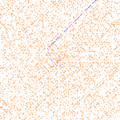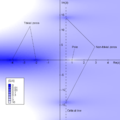Prime number

A prime number is a natural number that has exactly two divisors: one and itself. A natural number can be gotten by multiplying two numbers. These two numbers are called its divisors. Any natural number is equal to one times the number itself, so those two numbers are two of its divisors. A prime number is a number with only two divisors: one and itself.[1]
The prime numbers are the numbers other than one which are not equal to [math]\displaystyle{ m \times n }[/math] (except one times itself). The smallest prime number is two. The next prime numbers are 3, 5, 7, 11, and 13. The set of prime numbers is sometimes written as [math]\displaystyle{ \mathbb{P} }[/math].[2]
If the number has any other divisors besides one and itself, then the number is called a composite number. The smallest composite number is four, because two times two equals four; thus four has three divisors. One is not a composite number or a prime number because it only has one divisor, one.[1]
The fundamental theorem of arithmetic states that every positive integer can be written as a product of primes in a unique way,[3] though the way the prime numbers occur is a difficult problem for mathematicians. When a number is larger, it is more difficult to know if it is a prime number. One of the answers is the prime number theorem. One of the unsolved problems is Goldbach's conjecture.
There is no largest prime number. One of the most famous mathematicians, Euclid, recorded a proof that there is no largest prime number. However many scientists and mathematicians are still searching to find it as part of the Great Internet Mersenne Prime Search.
How to find small prime numbers
There is a simple method to find a list of prime numbers. Eratosthenes created it. It has the name Sieve of Eratosthenes. It catches numbers that are not prime (like a sieve), and lets the prime numbers pass through.
The method works with a list of numbers, and a special number called b that changes during the method. As one goes through the method, they circle some numbers in the list and cross out others. Each circled number is prime and each crossed-out number is composite.[4] At the start, all the numbers are plain: not circled and not crossed out.
The method is always the same:
- On a sheet of paper, write all the whole numbers from two up to the number being tested. Do not write down the number one. Go to the next step.
- Start with b equal to two. Go to the next step.
- Circle b in the list. Go to the next step.
- Starting from b, count up b more in the list and cross out that number. Repeat counting up b more numbers and crossing out numbers until the end of the list. Go to the next step.
- (For example: When b is two, you will circle two and cross out four, six, eight, and so on. When b is three, you will circle three and cross out 6, 9, 12, and so on. 6 and 12 have already been crossed out. Cross them out again.)
- Increase b by one. Go to the next step.
- If b has been crossed out, go back to the previous step. If b is a number in the list that has not been crossed out, go to the third step. If b is not in the list, go to the final step.
- After this point, all of the prime numbers are circled and all of the composite numbers are crossed out.
For example, one could carry out this method on a list of the numbers from 2 to 10. At the end, the numbers two, three, five, and seven will end up circled. These are prime numbers. The numbers 4, 6, 8, 9 and 10 will be crossed out. These are composite numbers.
This method or algorithm takes too long to find very large prime numbers. However, it is less complicated than methods used for very large primes, such as Fermat's primality test (a test to see whether a number is prime or not) and the Miller-Rabin primality test.
What prime numbers are used for
Prime numbers are very important in mathematics and computer science. Very long numbers are hard to solve. It is difficult to find their prime factors, so most of the time, numbers that are probably prime are used for encryption and secret codes.[5] For example:
- Most people have a bank card, where they can get money from their account using an ATM. This card is protected by a secret access code. Since the code needs to be kept secret, it cannot be stored in cleartext on the card. Encryption is used to store the code in a secret way. This encryption uses multiplications, divisions, and finding remainders of large prime numbers. An algorithm called RSA is often used in practice. It uses the Chinese remainder theorem.
- If someone has a digital signature for their email, encryption is used. This makes sure that no one can fake an email from them. Before signing, a hash value of the message is created. This is then combined with a digital signature to produce a signed message. Methods used are more or less the same as in the first case above.
- Finding the largest known prime number has, over the years, become a sport of sorts. Testing if a number is prime can be difficult if the number is large. The largest primes known at any time are usually Mersenne primes, because the fastest known test for primality is the Lucas-Lehmer test, which relies on the special form of Mersenne numbers.
Prime Number Media
Composite numbers can be arranged into rectangles but prime numbers cannot.
Demonstration, with Cuisenaire rods, that 7 is prime, because none of 2, 3, 4, 5, or 6 divide it evenly
The relative error of \tfrac{n}{\log n} and the logarithmic integral \operatorname{Li}(n) as approximations to the prime-counting function. Both relative errors decrease to zero as Template:Tmath grows, but the convergence to zero is much more rapid for the logarithmic integral.
The Ulam spiral. Prime numbers (orange) cluster on some diagonals and not others. Prime values of 4n^2 - 2n + 41 are shown in blue.
All Gaussian primes with norm squared less than 500
Related pages
References
- ↑ 1.0 1.1 C, Mohamed. "Is 1 a prime number or not?". www.tutorocean.com. Retrieved 2021-10-04.
- ↑ "Comprehensive List of Algebra Symbols". Math Vault. 2020-03-25. Retrieved 2020-10-07.
- ↑ Weisstein, Eric W. "Prime Number". mathworld.wolfram.com. Retrieved 2020-10-07.
- ↑ De Shalit, Ehud (2018). "Prime Numbers–Why are They So Exciting?". Frontiers for Young Minds. 6. doi:10.3389/frym.2018.00040.
- ↑ Graham Templeton (25 October 2013). "Geek Answers: Why should we care about prime numbers?". Geek: Science. Archived from the original on 19 February 2015. Retrieved 10 January 2015.
Other websites
- GIMPS, a group that searches for Mersenne primes








